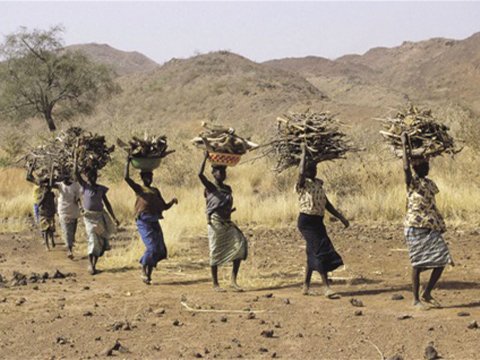At the beginning of each and every rainy season in Malawi, farmers in the villages across the nation are faced with one major decision to make - what to plant in their farms. Note that around 95% of annual precipitation in Malawi occurs during the warm-wet season which starts in November up to April (Malawi Meteorological Services, 2016). In most cases this decision is driven by the need of ensuring that the family has enough food on the table and money to buy relish plus other basic needs like soap, sugar, clothes, etc. Though it is assumed that the staple food for Malawi is “Nsima” (similar to polenta but uses a bit finer flour) we need to acknowledge that this is not the case in all districts. It all depends on the place where one comes from and geographical location because some Malawians especially in the North uses cassava flour, rice and banana more than maize flour. Together with the climate of the area, the food preference of the family is what helps them in deciding on what to plant for both consumption and sales.
…tobacco in Malawi…
However we cannot deny that tobacco is and remains the most favored cash crop amongst farmers especially in the central region. The statistics are all over the place to prove that tobacco is gold and preferred crop in Malawi. The volume of tobacco produced in the country is evidence of how much as a nation we love to grow tobacco. Malawi is amongst the top 10 countries in the world which produces 80% of world’s tobacco (FAO 2010). It is the country’s main foreign exchange earner making up over 53% of total exports (World Finance 2016). No wonder the government insists on growing tobacco regardless of the numerous calls around the globe to ban smoking which is in a way affecting the prices of tobacco on the auction floors.
…the trigger…
A couple of weeks ago as I was browsing the internet for news, I came across an article about one of the big international tobacco companies operating in Malawi. It was a good story because it mentioned that the company had plans to drill boreholes in some districts of the country so that tobacco farmers could have access to safe water. Some good corporate social responsibility on their part but which made me think if it was enough. Unfortunately I came to a conclusion that not much is being done on the ground to improve and preserve both the lives of the tobacco growers and their environment. I am not discrediting the efforts being made by these firms but I believe that more could be done. Most of you will agree with me that what we see in the media about the dangers of tobacco has to do with smoking but little is mentioned about the dangers of growing it especially in third world countries like Malawi as seen below. This is an area that I would like to highlight because though Malawi is one of the major producers of tobacco, only a few Malawians smoke. Maybe not literally but we are below the world rate of 36.22% and 6.9% in the year 2012 at 26.6% and 6.6% for males and females respectively (World Bank, 2016). These figures are astonishing to me as I expected less numbers of smokers because I know very few people who smoke in Malawi. Anyway, back to the dangers of growing tobacco.
…deforestation…
This might seem to be the most obvious problem associated with tobacco growing in Malawi and it is because of this reason that I will tackle it first.
Ever since I was young, I have been visiting both my fathers and mothers village. And I have witnessed how the landscapes have been changing over the years from green lush forests to bare lands. Trees in the vicinity of the villages are scarce. This has forced women to walk longer distances in search of firewood, the major source of energy for both heating and cooking in Malawi. Likewise, the prices of firewood and charcoal in the urban areas have been increasing as the sources have been diminishing. With poor ESCOM services, the electricity supplier in Malawi, I see no end in the near future to the reliance on trees for basic use. This is one more reason to protect our forests.
It is legitimate to say that there are more factors contributing to deforestation in Malawi but at the same time we cannot deny the fact that tobacco growing is one of the major culprits. Do you know that for every one hectare of flue- tobacco you need 3 hectares of trees? This is a gigantic amount of trees especially if you factor in the volume of tobacco grown in Malawi and that 15% of that is flue-cured (Masina quote Forestry Department, 2014). No wonder our forests are being depleted even if measures have been put in place to allow for afforestation. Afforestation on its own is not a solution to Malawi’s deforestation. Trees are being planted each and every year but results are not that visible. Most probably because only 10% of seedlings planted do survive (Thamala 2014). I am a bit skeptical though if it is really 10% of seedlings that survive but I can agree with Thamala that only few seedlings of trees planted do survive.
…green tobacco sickness (GTS)…
This is the least talked about health hazard associated with tobacco growing. The majority of the population does not even know of its existence. I found out about GTS over 2 years ago. Like most people I have talked to, I was surprised that it even exists. So, what is it and why are we not aware of its existence?
“Green tobacco sickness is acute nicotine poisoning due to nicotine poisoning through the skin” (The 2006 NORA Innovative Research Award Winner). Signs for GTS include nausea, headaches and dizziness. It affects tobacco labourers, those handling the cultivation and harvesting of tobacco. Usually it occurs when wet tobacco touches the skin. Knowing the cause of GTS might help farmers to take preventative measures. For example, they may have protective gear when working with tobacco especially wet tobacco. This is hard to implement as most farmers barely have 3 meals per day. They may avoid working in the morning hours when tobacco leaves have dew. And they may try to change clothes every time they get wet, whether from rain or sweat.
Not much information is available about GTS. By 2006, less than 40 scientific papers on GTS had been published. Confirming why only a handful of people know about it. It is a problem that the big corporates and estate owners do not want to discuss. I don’t think that companies like JTI or BAT do not know about GTS. But then why do we only have smoking warnings and not tobacco growing warnings? Is it because that it only affects the labourers? Or it affects the workers without a voice of their own? The people who are marginalised? The people who are not aware of the problems that they are putting on their lives by trying to make ends meet? Or the company balances are the most important thing? Maybe GTS does not pose a greater health hazard than smoking to the communities? But how can we conclude that if less research on it has been done? GTS might not kill you but is quality of life not important?
I have too many questions in my head but no answers. I would love to know why no one talks about GTS especially in Malawi, one of the main growers of tobacco. I just hope that by writing this article, I will help to bring awareness to GTS and in so doing empower others to get involved in GTS discussion. Who knows, on top of smoking warnings, we might have a tobacco growing warning in the future.
…solution…
It is true that we cannot shift from tobacco to other foreign exchange earners overnight as expressed recently by Dr. George Chaponda. But what worries me is the slow reaction of the government to find and implement working strategies that would take over from tobacco as Malawi’s major foreign exchange earner. The anti-smoking campaign has been around for quite some time now. If that has not been enough to persuade the government to find other means of earning foreign exchange, maybe highlighting the dangers of growing tobacco to the farmers and their communities will.
I strongly believe that diversification is the only way forward for Malawi. If we cannot adapt accordingly to the current trends in the world, we cannot move forward. Let us embrace the era in which we are living in and provide products that are not controversial but at the same time are on demand. We need to maximise on our strengths.
We are an agricultural nation, full of resources that are under utilised. As Felix Jumbe in 2013 said, if Malawi can sell 1 million tonnes each of beans, groundnuts, soya and pigeon peas to an international market, its foreign exchange reserves could be met in just a year. Why are we therefore not doing anything about it? Wake up Malawi…
…conclusion…
As the battle against smoking continues, we as a nation need to realise and accept that not only is the demand for our cash crop diminishing but also that there are dangers to our communities associated with growing tobacco which are not first page news though they are devastating.
…it’s high time Malawi diversifies and put the lives of the majority at the forefront…

